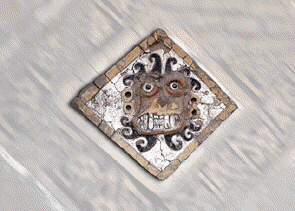There are
various recurring themes that aid us in reconstructing
the possible function of this building. Clearly, it was a
temple dedicated to the principal gods of Moche society,
gods linked to human sacrifice cults or to a general cult
to the dead. Some of these recurring themes include:
- a)The Huaca de la Luna lies at the
foot of a large hill, the most prominent in the
lower Moche valley. We know from the Spanish
chroniclers and from Colonial documents that
mountains were considered great "apus"
(deities) and were widely worshipped. Indeed, the
rock outcrop at the Huaca de la Luna is
surrounded by plaza 3, next to which the Moche
built a small platform, (platform 2). In
addition, many portrayals in Moche art of
sacrifice scenes feature a mountain with one or
two platform mounds at its base. These could well
be Cerro Blanco and the Huacas del Sol y de la
Luna.
- b)The recurring image of the
principal god (the Winged Decapitator) in the
murals and the reliefs in several construction
phases points to the continuity of the cult over
time.
- c)The discovery of officiants'
tombs in the fill which "buried" the
old buildings underscores the sacred nature of
this building.
- d)The small rooms with gabled
roofs and high windows recall those shown in
sacrifices depicted in narrative scenes. These
rooms may have served as places to prepare or
instruct those about to be sacrificed or those
who carried out the rite.
- e)Finally, only on the Huaca de la
Luna (platforms I and III) did archaeologists
find decorated walls and there is no evidence for
domestic activities, unlike the Huaca del Sol.
Possibly, the Huacas complemented each other,
with one serving an administrative function and
the other a religious one.
This new evidence allows us to suggest
interpretations which underscore the sacredness of the
site and its role in the composition of power in the
heart of Moche society. One of the more interesting
aspects that we have been able to reconstruct, albeit in
a fragmentary fashion, is the basic structure of the
ideology of power in Moche.
|


